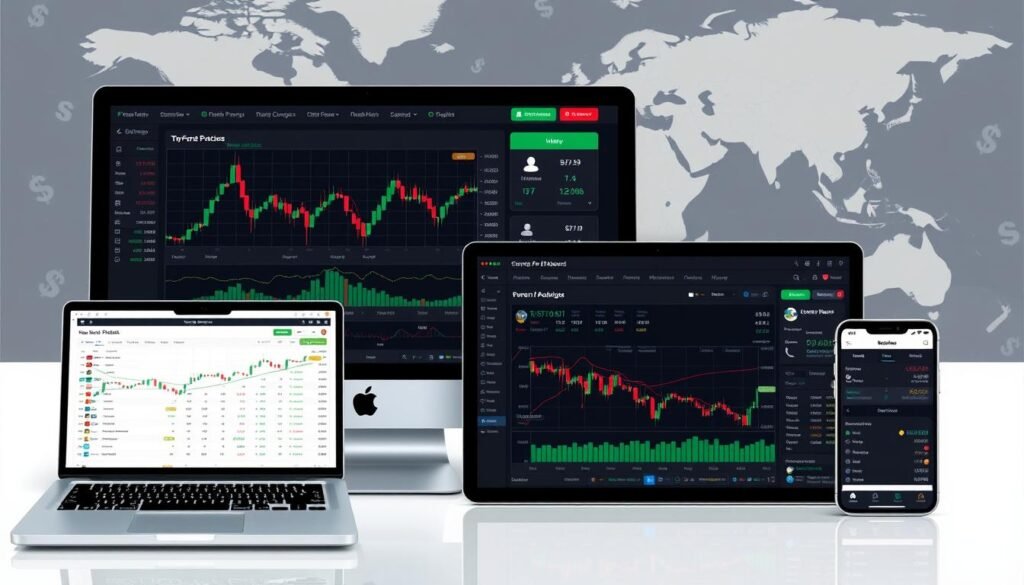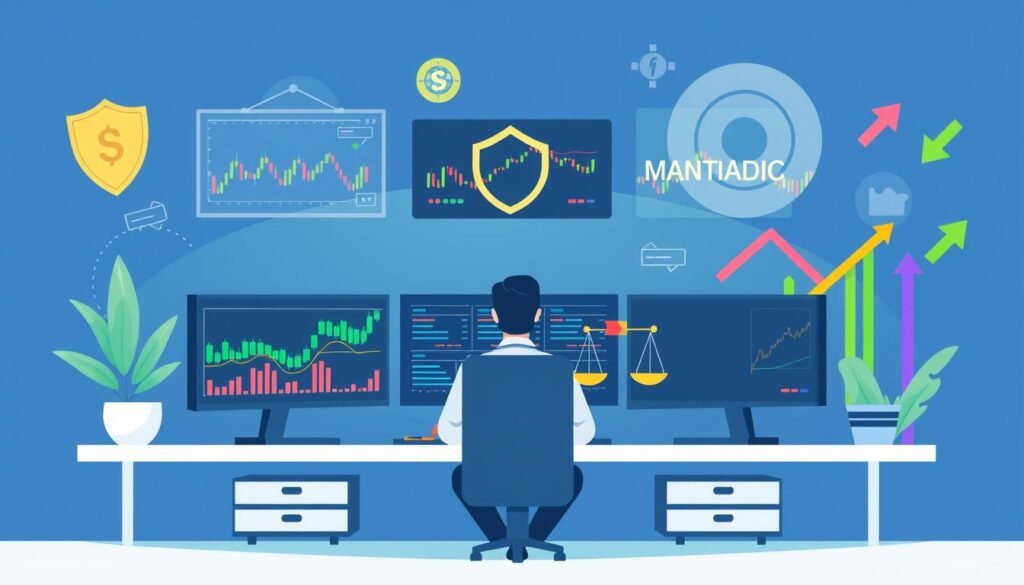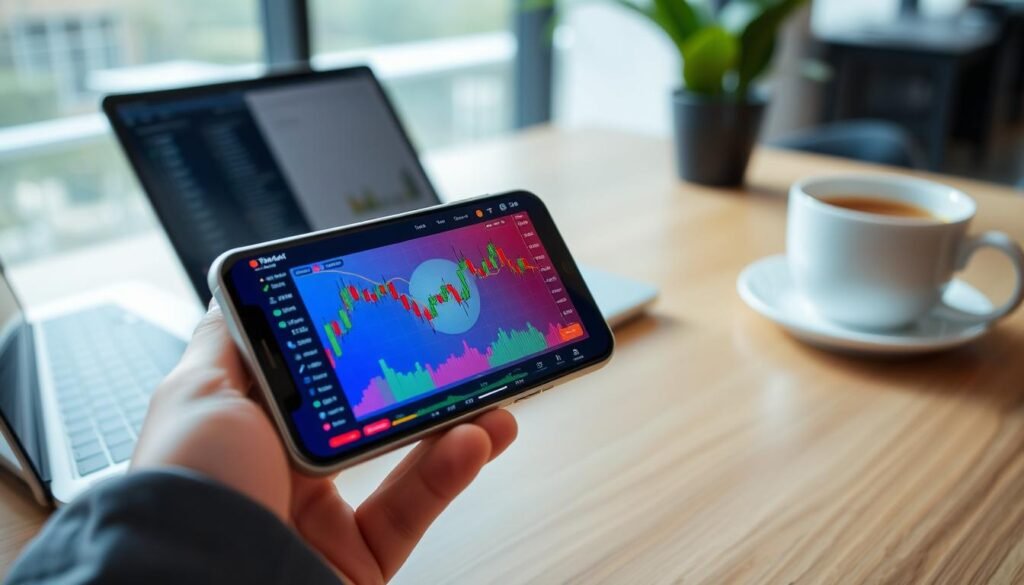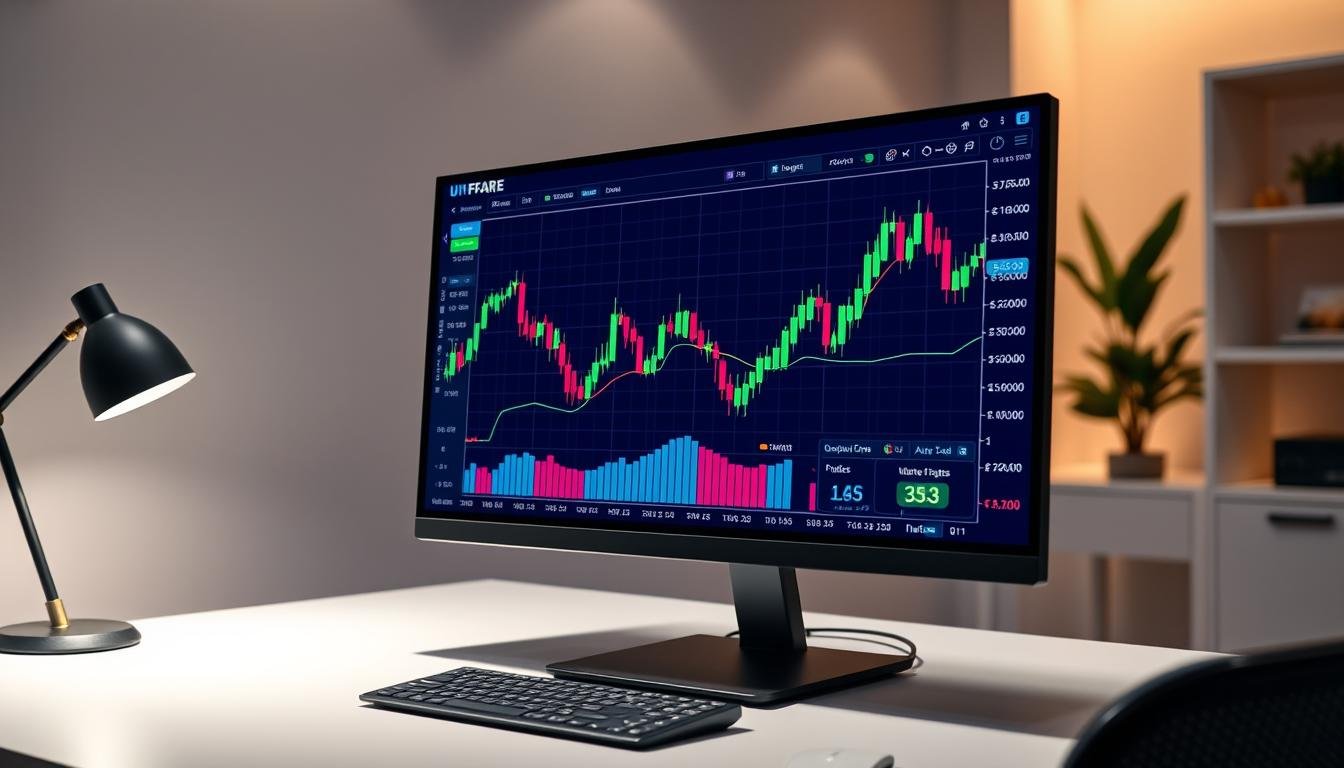Open Forex Account: Start Trading Today
Are you ready to explore the world of forex trading? Opening a forex account is your first step into the global currency market. With online trading platforms, you can trade from anywhere, at any time. Forex trading is perfect for both beginners and experienced investors, offering a chance to dive into the world of international currencies.
The currency market is open 24/7, five days a week. This makes it one of the most accessible financial markets globally. By opening a forex account, you join millions of traders who aim to make profits from currency price changes. If you want to add variety to your investments or start a new financial journey, forex trading might be your next move.
Key Takeaways
- Forex trading allows access to the global currency market
- Online platforms enable trading from anywhere, anytime
- The forex market operates 24/5, offering flexibility
- Opening an account is the first step to forex trading
- Forex offers opportunities for both new and experienced traders
- Currency trading can diversify your investment portfolio
Understanding Forex Trading: A Beginner’s Guide
Forex trading is key to global finance. This guide covers the basics, making it easy for newbies to get into currency exchange.
What is Forex Trading?
Forex trading is about buying and selling currencies. Traders try to make money from changes in exchange rates. The market is open 24/7, five days a week, making it huge and very liquid.
The Global Currency Market Explained
The forex market doesn’t have a central place for trades. Banks, financial firms, and individual traders are the big players. The most traded pairs are EUR/USD, USD/JPY, and GBP/USD.
| Currency Pair | Description | Market Share |
|---|---|---|
| EUR/USD | Euro/US Dollar | 28% |
| USD/JPY | US Dollar/Japanese Yen | 13% |
| GBP/USD | British Pound/US Dollar | 11% |
Key Benefits of Forex Trading
Forex trading has many good points:
- It’s very liquid, making it easy to get in and out of trades
- Transaction costs are low compared to other markets
- You can make money in both up and down markets
- Trading with leverage can increase your potential earnings
Knowing these basics is key for anyone starting in currency exchange. With the right education and practice, forex trading can be a great part of your investment strategy.
Choosing the Right Forex Broker
Finding the right forex broker is key to your trading success. A detailed comparison can help you find the best fit for you. Let’s look at important factors to consider.
Regulation is a top priority when choosing a broker. Choose regulated brokers to protect your funds and ensure fair trading. Look for the FCA, CFTC, and ASIC as reputable regulatory bodies.
Brokers offer different trading platforms. Look for platforms with good charting tools, real-time news, and mobile access. MetaTrader 4 and cTrader are popular choices.
Good customer support is crucial. Test how quickly they respond through chat, email, and phone. Having 24/5 support is great for constant market access.
Fees can affect your profits. Compare spreads, commissions, and overnight fees. Some brokers may have no commission but higher spreads.
| Broker Selection Criteria | Why It Matters |
|---|---|
| Regulation | Ensures fund safety and fair practices |
| Trading Platform | Affects ease of use and analysis capabilities |
| Customer Support | Critical for resolving issues quickly |
| Fee Structure | Directly impacts trading costs and profitability |
The right broker for you depends on your trading style, experience, and goals. Take your time to evaluate these factors before opening an account.
Open Forex Account: Steps to Get Started
Are you ready to start trading in the forex market? Opening a forex account is your first step. This guide will show you how to do it easily and quickly.
Research and Compare Brokers
First, look at different forex brokers. Find ones that are regulated, have good spreads, and reliable customer support. Compare them to find the one that suits your trading style best.
Gather Necessary Documents
Get ready to register your forex account by gathering important documents. You’ll need:
- Government-issued ID
- Proof of address (utility bill or bank statement)
- Tax identification number
Complete the Application Process
Next, fill out the broker’s online application form. Make sure your personal info and trading experience are correct. Then, send in your documents for verification. This step is important for following the rules.
Fund Your Account
After verification, it’s time to add money to your account. You can use bank transfers or credit cards. Start with an amount you feel comfortable risking.
| Step | Action | Tips |
|---|---|---|
| 1 | Research Brokers | Compare spreads, platforms, and customer reviews |
| 2 | Gather Documents | Ensure all documents are clear and up-to-date |
| 3 | Apply Online | Double-check all entered information for accuracy |
| 4 | Verify Account | Respond promptly to any verification requests |
| 5 | Fund Account | Start with a conservative initial deposit |
By following these steps, you’re on your way to starting your forex trading journey. Start small and keep learning as you go.
Essential Features of a Reliable Forex Trading Platform
Choosing the right forex platform is key to your trading success. Top platforms offer powerful features and are easy to use. Let’s look at what makes a platform stand out.

A good forex platform has an easy-to-use interface. This lets traders move quickly and make trades without hassle. MetaTrader is a favorite for its simple design and customizable space.
Charting tools are vital for serious traders. Look for platforms with many technical indicators, drawing tools, and timeframes. These help you understand market trends and make smart choices.
- Real-time quotes and news feeds
- Various order types (market, limit, stop)
- Risk management tools
- Automated trading capabilities
Mobile apps are now crucial. They let you check and manage trades anywhere, anytime.
“The best trading platforms combine powerful analysis tools with ease of use, giving traders the edge they need in the forex market.”
When picking a platform, check its speed and reliability. A slow or unreliable platform can cause big losses. Try the demo version to see if it fits your needs.
Types of Forex Accounts: Which One Suits You?
Forex account types are key in your trading journey. Knowing the differences helps you pick the right one for your goals and skill level. Let’s look at the main types of live trading accounts and demo options for forex traders.
Standard Accounts
Standard accounts are for seasoned traders. They need a bigger deposit and let you trade standard lots. This means you can handle bigger trades, which can lead to bigger wins or losses.
Mini Accounts
Mini accounts are great for those starting small. You can trade mini lots, which are a tenth of standard lots. This lowers your risk but still lets you into the market.
Micro Accounts
Micro accounts have the smallest lot sizes, perfect for beginners or those with little capital. You can trade micro lots, which are a hundredth of standard lots. They’re a safe way to get trading experience.
Demo Accounts
Demo trading is key for newbies. These accounts use fake money, letting you try strategies and learn without real money risk. Many brokers offer demo accounts to help new traders get used to the platform and market.
| Account Type | Minimum Deposit | Lot Size | Ideal For |
|---|---|---|---|
| Standard | $1000+ | 100,000 units | Experienced traders |
| Mini | $100-$500 | 10,000 units | Intermediate traders |
| Micro | $5-$100 | 1,000 units | Beginners |
| Demo | $0 (Virtual) | Varies | All skill levels |
Pick a forex account type that fits your trading style, risk level, and financial goals. Starting with a demo account is a good idea to practice before moving to live trading.
Forex Trading Strategies for Beginners
When you open a forex account, it’s crucial to develop effective forex strategies. Beginners often find themselves overwhelmed by the complexity of the market. Let’s explore some basic approaches to help you start your trading journey.

One popular strategy is trend following. This involves identifying the overall market direction and trading in line with it. Traders use technical analysis tools like moving averages to spot trends. Another approach is range trading, where you buy at support levels and sell at resistance levels within a defined price range.
Fundamental analysis is equally important. It involves studying economic indicators, political events, and other factors that influence currency values. Combining technical and fundamental analysis can lead to more informed trading decisions.
“The key to successful forex trading is not just strategy, but also discipline and risk management.”
Speaking of risk management, it’s a critical aspect of forex trading. Always use stop-loss orders to limit potential losses and take-profit orders to secure gains. Proper position sizing is another vital risk management technique.
| Strategy | Key Tools | Suitable for |
|---|---|---|
| Trend Following | Moving Averages, Trend Lines | Long-term traders |
| Range Trading | Support and Resistance Levels | Short-term traders |
| News Trading | Economic Calendar | Fast-paced traders |
Remember, no single strategy works all the time. Successful traders often adapt their approach based on market conditions. Start with a demo account to practice these strategies before risking real money.
Understanding Forex Pairs and Market Analysis
Forex trading is all about currency pairs. These pairs are the base of the market and control price changes. We’ll look at the different types of pairs and how traders analyze them.
Major, Minor, and Exotic Currency Pairs
Currency pairs fall into three main groups. Major pairs include the most traded currencies like USD, EUR, and JPY. Minor pairs don’t have the USD but include other big currencies. Exotic pairs mix a major currency with one from a smaller or new economy.
Fundamental Analysis in Forex
Fundamental analysis looks at economic factors that affect currency values. Traders check interest rates, GDP growth, and political news. This helps predict long-term trends in the forex market.
Technical Analysis Tools and Indicators
Technical analysis uses charts and indicators to guess price changes. Tools like moving averages, relative strength index (RSI), and Bollinger Bands are popular. These help traders find the best times to buy or sell.
| Analysis Type | Focus | Key Tools |
|---|---|---|
| Fundamental | Economic factors | Economic reports, news |
| Technical | Price patterns | Charts, indicators |
Good forex analysis mixes both fundamental and technical methods. By knowing about currency pairs and using these analysis tools, traders can make smart choices in the fast-paced forex market.
Risk Management in Forex Trading
Forex trading is thrilling, but managing risks is key. Smart traders use stop-loss orders to cap losses. These orders close a trade if the price moves against you by a set amount. It’s like having a safety net for your trades.
Take-profit levels are also crucial. They lock in profits when a trade reaches a certain price. This way, you don’t miss out on gains if the market suddenly turns.

Position sizing is vital for protecting your account. It means deciding how much of your capital to risk on each trade. A common rule is not to risk more than 1-2% of your account on a single trade. This helps you stay in the game even if you have a string of losses.
| Risk Management Tool | Purpose | Benefit |
|---|---|---|
| Stop-loss orders | Limit potential losses | Protects capital |
| Take-profit levels | Secure profits | Locks in gains |
| Position sizing | Control risk exposure | Preserves account balance |
Remember, successful forex trading isn’t just about making profits. It’s about managing risks and preserving your capital. By using these tools wisely, you can trade with more confidence and stay in the market for the long run.
Leveraging and Margin in Forex: What You Need to Know
Forex leverage and margin trading can increase your profits, but they also raise the risk. It’s key to understand these concepts for successful trading and managing risk.
Understanding leverage ratios
Forex leverage lets you manage big positions with a small amount of money. Leverage ratios vary from 1:10 to 1:500. For example, with a 1:100 leverage, you can control $100,000 with just $1,000.
Margin requirements explained
Margin is the money needed to start and keep a leveraged position. It’s a percentage of the total position size. For example, a 1% margin means you need $1,000 for a $100,000 position.
| Leverage Ratio | Margin Requirement | Position Size |
|---|---|---|
| 1:100 | 1% | $100,000 |
| 1:50 | 2% | $50,000 |
| 1:20 | 5% | $20,000 |
Pros and cons of using leverage
Forex leverage can increase your profits by making small price changes more impactful. It also lets you trade larger amounts with less money. However, leverage can also increase losses, leading to quick account depletion if not managed well. It’s vital to assess risks when using leverage in forex trading.
- Pros: Amplified profits, larger positions
- Cons: Increased risk, potential for significant losses
While leverage can enhance your trading power, it’s important to use it carefully and have a solid risk management plan.
Forex Trading Hours and Market Sessions
The forex market is open 24/7, five days a week. It offers chances for traders all over the world. Knowing when to trade is key to success.
The market is split into four main times: Sydney, Tokyo, London, and New York. Each time affects how easy it is to trade and how much the market moves.
| Trading Session | Opening Time (EST) | Closing Time (EST) | Major Currencies |
|---|---|---|---|
| Sydney | 5:00 PM | 2:00 AM | AUD, NZD |
| Tokyo | 7:00 PM | 4:00 AM | JPY |
| London | 3:00 AM | 12:00 PM | EUR, GBP |
| New York | 8:00 AM | 5:00 PM | USD, CAD |
Liquidity changes with each session. The best time for trading is when London and New York overlap. This is when spreads are tight and opportunities abound.
Choose your trading strategy and currency pairs wisely. Some pairs are more active at certain times. This matches the business hours of their countries.
Common Mistakes to Avoid When Opening a Forex Account
Starting your forex trading journey is exciting. But, it’s key to avoid common pitfalls. New traders often make mistakes that can stop their progress. Let’s look at some common mistakes and how to dodge them.
One big mistake is not understanding trading psychology. Emotional decisions can lead to bad trades and big losses. It’s vital to have a disciplined mindset and follow your trading plan.
Another mistake is not managing risk well. New traders might risk too much on one trade, risking their whole account. Use strict stop-loss orders and limit your risk per trade to protect your money.
“The key to successful forex trading is not just about making money, but also about preserving your capital.”
Many beginners don’t value education enough. Jumping into live trading without learning can cost a lot. Spend time learning about currency pairs, market analysis, and trading strategies before risking real money.
| Common Mistake | How to Avoid |
|---|---|
| Emotional trading | Develop a trading plan and stick to it |
| Overtrading | Set daily limits on trades |
| Ignoring stop-losses | Always use stop-loss orders |
| Chasing losses | Accept losses as part of trading |
By avoiding these common mistakes and focusing on learning, you’ll do better in the forex market.
Mobile Forex Trading: Trade on the Go
The rise of mobile trading has changed the forex market. Now, traders can access markets and manage portfolios from their smartphones. This flexibility has made forex apps popular among all traders.
Top Mobile Trading Apps
Leading forex apps have great features and easy-to-use interfaces. MetaTrader 4, eToro, and Plus500 are some top choices. They offer real-time quotes, charts, and news updates, helping traders make quick decisions.
Essential Features for Mobile Platforms
When picking a mobile trading platform, look for these key features:
- Real-time price updates
- Advanced charting tools
- One-click trading
- Customizable alerts
- Sync across devices

Security Considerations
Trading on smartphones needs extra care. Use strong passwords, enable two-factor authentication, and avoid public Wi-Fi. Reputable apps use encryption to protect your data and transactions.
| Feature | Importance | Benefit |
|---|---|---|
| Real-time Updates | High | Timely decision-making |
| User Interface | Medium | Easy navigation |
| Security Measures | Critical | Protection of funds and data |
Mobile trading offers unmatched convenience. But, it’s key to choose a reliable app and focus on security. With the right tools and precautions, you can trade forex anywhere, anytime.
Forex Education Resources for New Traders
Starting your forex learning journey can be overwhelming. But, many resources are here to help you build a solid foundation. Trading courses and educational webinars are great for understanding the forex market and improving your skills.
Online trading courses offer a structured way to learn about forex. They cover important topics like market analysis, risk management, and trading strategies. Many brokers have free or low-cost courses for beginners, letting you learn at your own pace.
Educational webinars are also valuable for new traders. These live online sessions feature experienced traders sharing insights and answering questions. Webinars cover a range of topics, from basic forex concepts to advanced trading techniques.
- E-books and trading guides
- Video tutorials and trading simulations
- Forex trading forums and community discussions
- Economic calendars and market news feeds
Using a mix of these resources can speed up your forex learning. Always practice with a demo account first. And, stay updated with the latest market trends and educational materials.
“Education is the passport to the future, for tomorrow belongs to those who prepare for it today.” – Malcolm X
Investing time in forex education prepares you for the complex world of currency trading. It increases your chances of success in the long run.
Regulatory Compliance and Forex Brokers
Forex regulations are key to protecting traders. When you start trading, picking a compliant broker is crucial. Good brokers get licenses that show they follow the rules.
Worldwide, financial bodies watch over forex markets. In the US, the CFTC and NFA keep an eye on brokers. The FCA does the same in the UK, and ASIC in Australia.
Choosing a regulated broker has many benefits:
- Client funds are safe
- Trading is fair
- Prices are clear
- There are ways to solve disputes
Before you start trading, check if your broker is regulated. Look for their license on their site and check it with the financial authority. This makes sure you’re working with a real and responsible broker.
“Choosing a regulated forex broker is the first step towards safe and secure trading.”
Remember, rules for forex trading differ by country. Some places have stricter rules than others. Knowing the rules in your area helps you make better choices for your trading.
Building a Successful Forex Trading Plan
A solid trading plan is key to success in the forex market. It helps you stay focused and make smart choices. Let’s look at how to create a plan that works for you.
Setting realistic goals
Start by setting clear, achievable goals. Think about what you want to gain from forex trading. Do you aim to make a steady income or grow your wealth over time? Write down your goals and make sure they match your skills and resources.
Developing a trading strategy
Next, craft a strategy that fits your style. This includes choosing which currency pairs to trade, when to enter and exit trades, and how to manage risk. Test your strategy on a demo account before using real money. Remember, a good strategy development process takes time and patience.
Importance of keeping a trading journal
Lastly, keep a trading journal to track your progress. Write down every trade, including why you made it and how it turned out. This helps you spot patterns and improve your trading plan over time. A well-kept journal is a powerful tool for growth in the forex market.
